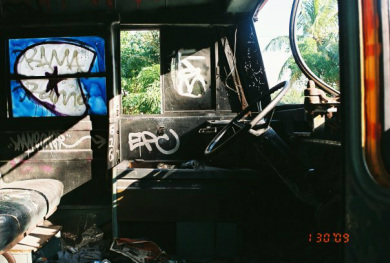Hidden Miami
Miami's out of the way places in Film and Music

Miami is a large sprawling bit of everything—part ghetto, part paradise. Gorgeous beaches, exotic nightlife, urban decay, ethnic, multi-linguistic-enclaves, national sports teams, symphony orchestras, beautiful early 20th century Art Deco buildings, as well as some of the most original street art in the world, all existing at the edge of one of North America's largest and most unique swamps.
If there’s anything more beautiful than Miami on a warm, winter’s day or in early spring, I can’t think of what that might be. White clouds set off against the deepest blue skies, green palms swaying in the breeze, yellow sand beaches and bottomless blue-green water provide an Eden-like backdrop to live in and move through. We experience this year round. Cold fronts are rare and seldom last more than a few days, with the peculiar notion of what constitutes cold, redefined as the result of living in the only sub-tropical environment in the continental U.S. Yes, it gets too hot in summer, but there’s always the miracle of air-conditioning, as well as endless beaches to cool off in.
Below, are three films shot in various places, outside of the normal tourist destinations shown in travel brochures. The first film, "Miami Orpheus," was shot at a man-made Atoll, just off the bay in South Miami, right before it tapers off into the Florida Keys. It was one of those days when the weather was perfect; the water was almost too cold, but, as the sun warmed, it became just right. There was only a smattering of people on the beach; in fact, it was so comfortable that I fell asleep on a blanket, under a large palm tree. The music was composed and performed for the film "Black Orpheus" by Luis Bonfa
If there’s anything more beautiful than Miami on a warm, winter’s day or in early spring, I can’t think of what that might be. White clouds set off against the deepest blue skies, green palms swaying in the breeze, yellow sand beaches and bottomless blue-green water provide an Eden-like backdrop to live in and move through. We experience this year round. Cold fronts are rare and seldom last more than a few days, with the peculiar notion of what constitutes cold, redefined as the result of living in the only sub-tropical environment in the continental U.S. Yes, it gets too hot in summer, but there’s always the miracle of air-conditioning, as well as endless beaches to cool off in.
Below, are three films shot in various places, outside of the normal tourist destinations shown in travel brochures. The first film, "Miami Orpheus," was shot at a man-made Atoll, just off the bay in South Miami, right before it tapers off into the Florida Keys. It was one of those days when the weather was perfect; the water was almost too cold, but, as the sun warmed, it became just right. There was only a smattering of people on the beach; in fact, it was so comfortable that I fell asleep on a blanket, under a large palm tree. The music was composed and performed for the film "Black Orpheus" by Luis Bonfa
The second film, "Miami: River City Blues," was shot in and around Jose Marti Park on the banks of the Miami River. A neighborhood built beneath a massive overpass, with a few upscale restaurants, one of the city’s oldest hotels, a historical civil war era slave quarters and one of the nation’s oldest Masonic Lodges. At its center is a playground and community center, used primarily by Miami’s Cuban expatriates. Its diversity is a compressed expression of the larger city. Barbed wire frames one end of the neighborhood with large, modern, bayfront condos just beyond. The other side is the river, with aging boats lining the waterway, crab traps stacked ten feet high, homeless people huddled at its fringes with wealthy patrons being served the just-caught seafood in upscale eateries. Music composed by Duke Ellington performed by The John Coltrane Quartet.
The third video was shot on a beautiful day in late summer at Greynolds Park in Miami. It was intended as a kind of homage to the local PBS station and the kind of innocuous programming that might be seen on a Sunday afternoon dealing with the local scene and its environment. It's been referred to by various family members as the "raccoon movie," I prefer to think of it as the "Citizen Kane of Raccoon cinema." The music "Kathy's Waltz" was composed by Dave Brubeck and performed by the Dave Brubeck Quartet.
These three films represent a very small part of what makes Miami fascinating. It seems as though every turn of the city and its outlying areas offers a different cultural perspective about life as reflected by the people that live in its many unique neighborhoods.
If asked what heaven might be like; for me, it would be an endless tank of gas, a couple of cameras, my wife by my side, enough money to be able to hit that little out of the way, funky mom and pop diner, checking out the local flea markets and thrift stores, on a warm spring day, with Florida's endless beaches and backroads just beyond the edge of every horizon. If it gets better than that, let me know, but I don't believe that it does.
Mark Magula
If asked what heaven might be like; for me, it would be an endless tank of gas, a couple of cameras, my wife by my side, enough money to be able to hit that little out of the way, funky mom and pop diner, checking out the local flea markets and thrift stores, on a warm spring day, with Florida's endless beaches and backroads just beyond the edge of every horizon. If it gets better than that, let me know, but I don't believe that it does.
Mark Magula